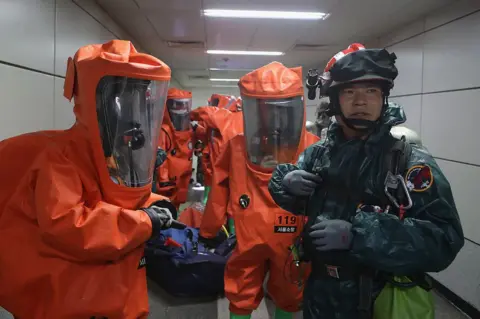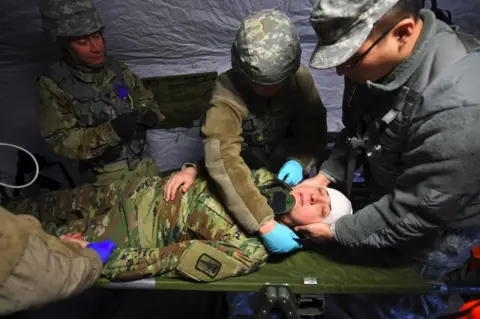US-South Korea hold military drills amid tension
The US and South Korea are conducting annual military drills which consistently infuriate Pyongyang, despite appeals to halt the exercise.
Last week North Korea appeared to back down from a threat to send missiles towards the US Pacific island of Guam, but said it would watch US actions.
It has already condemned these drills as pouring "gasoline on fire".
Washington describes the drills as defensive in nature, but the North sees them as preparation for invasion.
China and Russia had in July proposed a halt on military exercises in exchange for a freeze on missile tests.
But Joseph Dunford, chairman of the US Joint Chiefs of Staff, said last week that the military exercises were "not currently on the table as part of the negotiation at any level" and the Ulchi-Freedom Guardian (UFG) exercises were going ahead as planned.
About 17,500 US troops and 50,000 South Korean troops are involved in the exercises, which will last for about 10 days.
After North Korea's threats against Guam and an almost unprecedented war of words over Pyongyang's repeated missile tests, analysts have warned that the joint drills may be seen as a provocation at a particularly sensitive time.
On Sunday an editorial in North Korea's official government newspaper, the Rodong Sinmun, said the exercises would worsen the state of the peninsula and warned of an "uncontrollable phase of a nuclear war".
South Korea's President Moon Jae-in responded on Monday that Pyongyang should not use the exercises "as a pretext for aggravating the situation", reported Yonhap news agency.
The drills have also been met with some opposition in South Korea, where protests were held on Monday.
What are these drills?
The US and South Korea hold two sets of war games every year, involving a massive number of troops and military hardware.
Foal Eagle/Key Resolve is usually held in spring, while Ulchi-Freedom Guardian (UFG) is in autumn.
Both involve land, sea and air military drills and computer simulations. Held in South Korea, they have also involved practice drills for terror and chemical attacks in recent years.
 Getty Images
Getty ImagesThey can also sometimes involve troops from other allies - last year's UFG saw the participation of nine other countries.
What has the North said?
Both events routinely anger North Korea, which insists that the exercises are rehearsals for an invasion.
The country's media rhetoric over the drills has steadily intensified over the past three years and these exercises are being portrayed as a particularly strong provocation, BBC Monitoring reports.
In 2014 North Korean media warned of an arms race but used comparatively restrained language, saying Pyongyang's "self-defensive measures" - its nuclear and missile testing - would become "annual and regular" as long as the exercises continued.
The next year, state-run Rodong Sinmun newspaper warned that the drills represented "deliberate defiance against our active efforts to ease tension".
And in 2016, state-run paper Minju Joson warned that North Korea would "constantly strengthen our self-defensive nuclear deterrent" in response. Within weeks, Pyongyang tested a nuclear warhead.
 Getty Images
Getty ImagesThis year, Sunday's Rodong Sinmun said the situation on the Korean peninsula was a "touch-and-go crisis that has never been experienced before".
Earlier this year during Foal Eagle/Key Resolve, it warned it would "mercilessly foil the nuclear war racket of the aggressors with its treasured nuclear sword of justice".
But while it has frequently threatened serious retaliation, North Korea usually ends up conducting shows of force, such as firing missiles or moving troops.
Last week, in what was seen as a de-escalation, leader Kim Jong-un said he would watch "a little more" before launching missiles in the direction of Guam.
 AFP/Getty Images
AFP/Getty ImagesHave the drills caused conflict before?
Depending on the political climate, the drills have at times exacerbated tensions between the two sides.
The UFG drill in 2015 took place amid high tensions, which resulted in North and South Korea exchanging artillery fire across the border.
Military officials took the unusual step of halting the UFG while emergency talks were held between the North and South. The drill resumed several days later.
The US and South Korea say that the exercises are purely for defence purposes, and based out of a mutual defence agreement they signed in 1953.
They also say the exercises are necessary to strengthen their readiness in case of an external attack.
